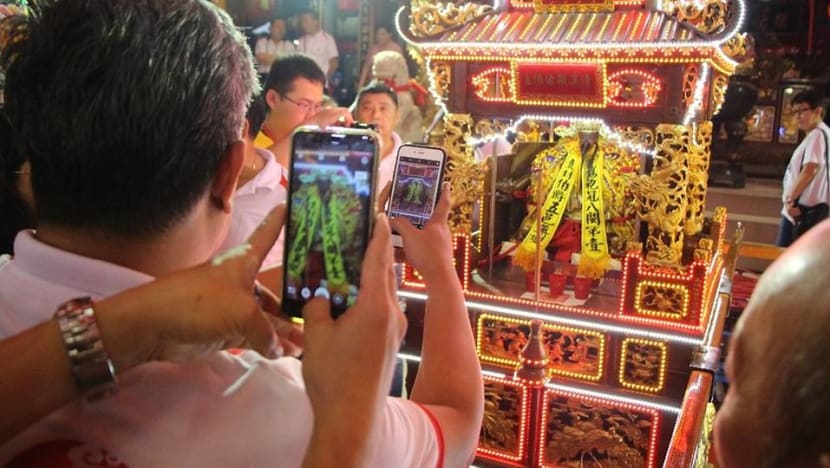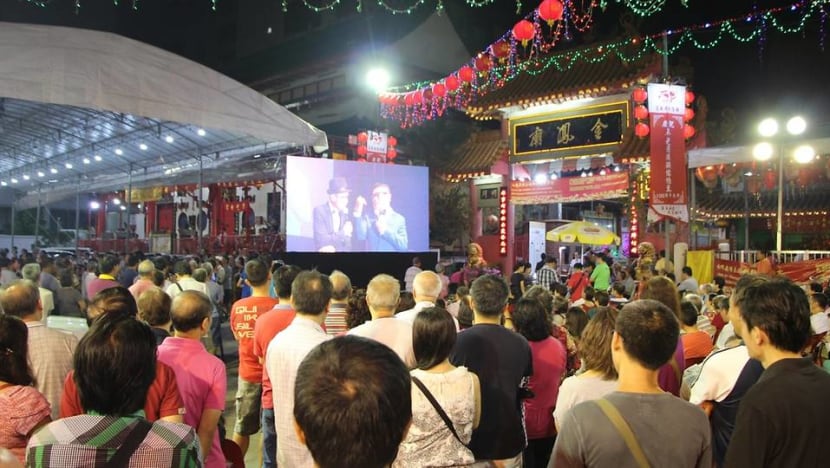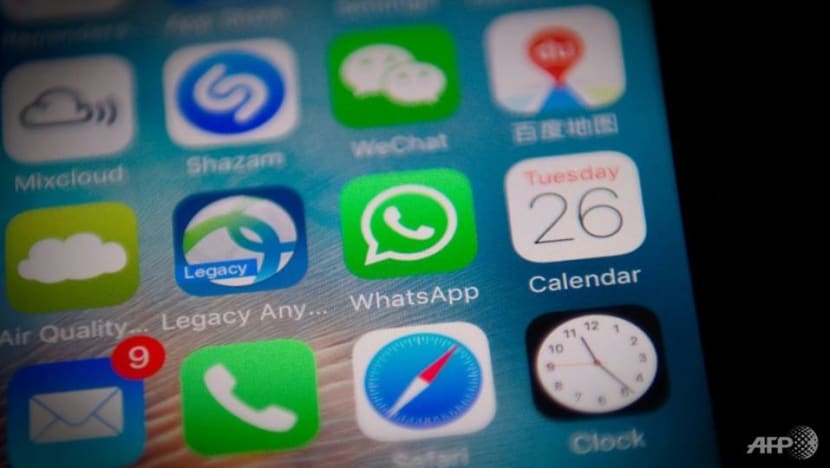commentary Commentary
Commentary: Drone cameras and social media pages, how religion keeps up with the digital age
But religion also has to contend with the invasion of religious spaces by smartphones and its associated challenges, says NUS’ Assistant Professor Alvin Eng Hui Lim.

Lorong Koo Chye Sheng Hong Temple’s 100th year anniversary, when the main effigy from Anxi, China visits the fifth effigy of Anxi Cheng Huang Ye in Singapore. (Photo: Alvin Lim)
SINGAPORE: For the past nine years in my research on religious practices in Singapore, I have noticed the growing use of media and digital technology.
Many Chinese temples have become attuned to social media, setting up their own Facebook pages, and employing digital technology, from selling recordings of their festivals on DVDs, to flying drones over the heads of their devotees and curious onlookers as they film the temple’s processions.
It was once important to veil altar spaces or effigies with yellow cloths as a mark of respect for their sacredness.
That has now been replaced in some cases with the use of video cameras to document the space and the spirit possessions that take place. Devotees can also upload and share videos of these private rituals online with the internet.
READ: Commentary: Cemeteries should be more than where the dead reside
BIGGER REACH, MORE PLATFORMS
Many religions also live-stream rituals and religious events through Facebook and YouTube. The Hindu Endowments Board, for example, has in recent years provided live-streaming of key Hindu processions such as the annual Fire Walking Festival.
Religious practices once unseen and even unheard of, are now actively showcasing their events and rituals. Spirit mediums are now posing for the camera before carrying out divine interventions and rites.
As religion meets the digital, this has profound implications to how we relate to our religious beliefs, gods, and fellow believers.
Religious groups in Singapore are acutely aware of the possibilities new technologies bring.
For one, many religious institutions and leaders now have a significant digital footprint across many platforms where followers can connect with them.

Christian pastors in Singapore also have a prominent online presence since the advent of online social media, first with Twitter and Facebook, and now Instagram.
They have also learnt how to use Instagram Stories to deliver bite-size messages, promote longer recordings of sermons and share news, photos and videos of the missionary work that they do around the world.
READ: Commentary: The awkwardness of using Instagram as a 50-something
New media has refreshed popular forms of religion in Singapore, involving the younger generation in promoting, documenting, and learning from their elders the ways and practices of their religion.
Involving the young have in turn helped religious practices and traditions to be refreshed and adapt to new technology, ensuring that religion remain relevant. As a result, gods and religious leaders are now more accessible to their devotees.
SHARES SPACES, SHARED GESTURES
Still, not everyone is comfortable with the proliferation of technology in our sacred spaces. For many, technology cannot replace the face-to-face and their relationship with their gods.
For others, technology can facilitate other forms of interaction that builds relationships and affirms their commitment to a community.
We are likely to find that both can co-exist in a diverse religious landscape. In the last few years, when visiting a religious festival at the temple, I have observed many devotees raising their camera phones in unison to capture an image of their god.
While the offering of joss sticks may be the main gesture done in honour of a deity, for some, this is quickly followed by a photo-taking gesture to commemorate the act.
This simple transition from tradition (offering of joss sticks) to remembrance (whipping out our smartphones) expresses a novel way in which we maintain a connection with a divine being.
READ: Commentary: Finding filial duty, spiritual charity in Hungry Ghost Festival rituals

In some ways, this is not new, at least for popular Chinese religion, as devotees have also carried home talismans and amulets from the temple in the past, to take a piece of the divine back with them.
CONNECTING A COMMUNITY
A getai performance at Sheng Hong Temple I attended shed light on how technology can bring big religious communities together.
Unable to get into the performance space to watch the getai show, the crowd spilled onto the driveway just outside the temple and stayed there for hours, standing and watching the screen which showed the performances.
READ: Commentary: Careful with photos you post online. You may be putting your digital identity at risk
The Taiwanese celebrities invited to the show no doubt played a part in drawing in the crowds, but it is telling that a screen had such magnetic power.
In so doing, the audiences shared a moment together, their gaze held by the events unfolding on the screen.
This happens in secular performances and concerts too, where we might prefer to focus on the large projection screens because it is impossible for us to see the facial expressions and actions of the performers from our seats.
What the use of technology for religion shows us is how much we strive to connect with the unseen. Media technology allows us to overcome uncertainty and distance.
After all, a religious experience need not be confined to an altar or sacred space, but can happen through our everyday interactions with technology.
WIDELY DISSEMINATED MESSAGES
There is no doubt popular religion in Singapore has now extended to the digital space and become more public.
There is, however, a flipside to this as religion online shares this virtual space with other forms of social media — videos, tweets, songs played from Spotify, Instagram stories, Snapchat notifications, gifs and memes shared across WhatsApp, Facebook messenger or Telegram, Tik Tok notifications, emails, pop-ups, and advertisements of a product that you may have been browsing on Shopee.

READ: Commentary: The iPhone 11 and Apple’s most ambitious play ever
The effect is religion can be outsized by the other distractions on social media, given the Internet’s expanse and 24/7 work email at your fingertips, vying for your attention.
Just as technology has powered religion, the smartphone has also brought life’s other priorities into the houses of our gods.
GUARDING AGAINST INTOLERANCE
The risk however is also that this same digital space can be a site for bigotry and religious intolerance, accentuated by falsehoods and “fake news”—a term that has perhaps become too quickly used to label any news that do not align to our beliefs and expectations.
This calls for added vigilance — not everything shared on WhatsApp, for instance, is real or had happened in Singapore, as the recent photograph of a falling roof mistaken to have happened at Changi Airport Jewel shows.
As a society, we have much to learn to manage our digital spaces, be more discerning of sensationalist messages we receive, and more responsible when connecting with others.
Sometimes, we may be too quick to hit “send” and “share”.
READ: Commentary: How to avoid accidentally becoming a Russian agent

When we create multiple versions of ourselves on different social media platforms, it can be easy to passively divorce ourselves from the need to be responsible for our thoughts and actions, and mindful of how they may come across to others.
Gods do not yet have their own social media profiles but as their stewards, there is just that ethical responsibility to represent them.
Alvin Eng Hui Lim is Assistant Professor at the National University of Singapore Faculty of Arts and Social Sciences, where he does research on local religious performances and the use of digital technology in religion and theatre.














